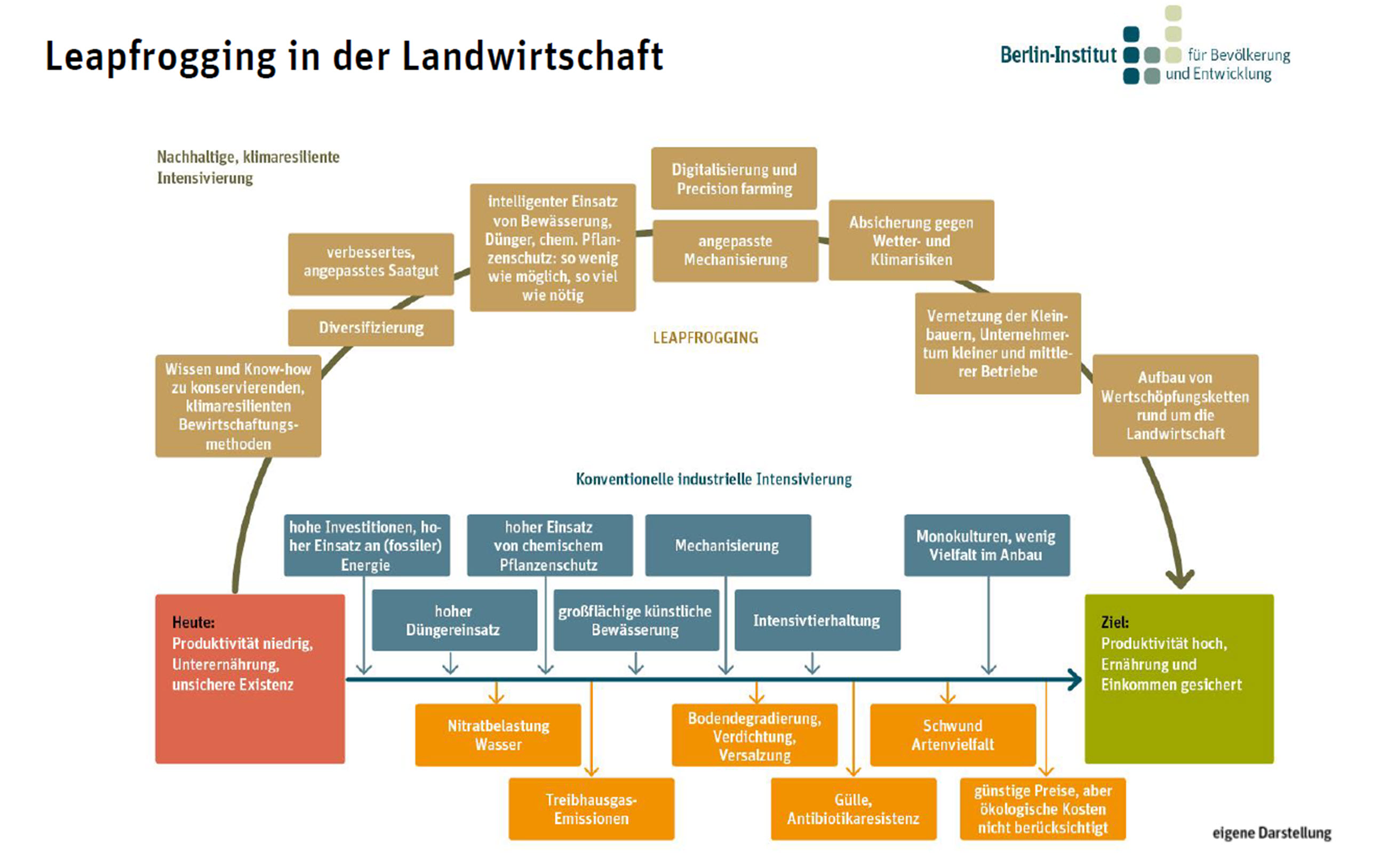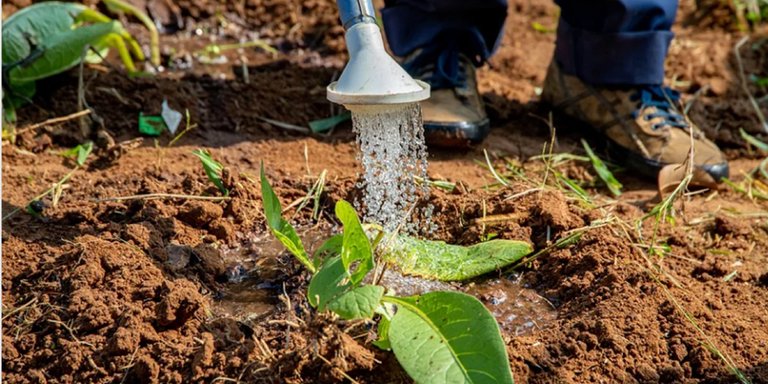The world is facing a dilemma: in order to fight global hunger, agricultural production must increase. At the same time, agriculture, as a major emitter of climate-damaging greenhouse gases, contributes to global warming. What ways can lead out of this dilemma were outlined by the experts at the Dialogue Forum special on the occasion of the “Münchner Klimaherbst” 2021. The event was moderated by Florian Kienast, Bayrischer Rundfunk.
The facts have been on the table for a long time: according to surveys by Welthungerhilfe around 690 million people suffer from hunger, and two billion are affected by malnutrition. On the other hand, around 40 percent of climate-damaging greenhouse gas emissions come from the global food system, i.e. the production, processing, transport and consumption of food. It is mainly small farms that provide people with food. "Of the more than 600 million farms worldwide, over 80 per cent have less than two hectares of cultivable land," explained Christel Weller-Molongua, Head of Department Rural Development and Agriculture at the Deutsche Gesellschaft für Internationale Zusammenarbeit (GIZ). In the global South, 500 million smallholders produce 70 percent of the food. According to Weller-Molongua, they are already suffering from the effects of climate change, such as droughts, but also erosion due to increasing heavy rainfall, among other things, resulting in the loss of more than ten million hectares of arable land every year.
There is no one approach to more sustainable agriculture, but we need to balance environmental, social and economic goals, taking into account the local context
Christel Weller-Molongua
GIZ
Considering the local context
In addition to land loss, there are other factors that stand in the way of sustainable food production: Food losses during production and processing is one. The increasing specialisation towards monocultures, also in developing and emerging countries, which makes the increased use of fertilisers necessary, is another. "There is no one approach to more sustainability in agriculture; we have to reconcile ecological, social and economic goals while taking the local context into account," Weller-Molongua is convinced. This includes soil protection measures and resource management, as well as optimised supply chains. She called for a stronger role for women. "They often form the backbone of agriculture and, unlike men, think more in terms of healthy nutrition for their families." According to studies by the Food and Agriculture Organisation of the United Nations (FAO), some places could harvest 20 to 30 per cent more if women had the same access to inputs as men.
© Christian Hülsebusch, DITSL
There is no true or false when it comes to shaping the future of agriculture; we must be guided by scientific findings
Christian Hülsebusch
German Institute for Tropical and Subtropical Agriculture, Transdisciplinary and Socio-Ecological Land Use Research (DITSL)
"There is no true or false when it comes to shaping the future of agriculture; we must be guided by scientific findings," appealed Dr. Christian Hülsebusch, Executive Director of the German Institute for Tropical and Subtropical Agriculture, Transdisciplinary and Socio-Ecological Land Use Research (DITSL). The goal must be to make agriculture more energy-efficient, adaptive, diverse, regional and loss-free. This means, for example, paying more attention to methane emissions and minimising the use of artificial fertilisers, fuels and synthetic pesticides. Or seeing the soil not only as a production platform, but also considering the production of food as part of site-specific ecosystems. Promising approaches include intercropping, i.e. the cultivation of two or more plants in the immediate vicinity, and agroforestry systems (cultivation of trees or shrubs on agricultural land).
Long supply and processing chains are problematic
In addition, efforts must be made to shorten supply and processing chains. This would allow the added value of processing to benefit local people, and up to 20 per cent of the harvest in the case of cereals, or even up to 70 per cent in the case of fruit and vegetables, would not be lost on the way to the consumer, as is currently the case. "If this can be achieved, it would be easy to make up for the lower productivity of ecosystem-based agriculture," Hülsebusch is convinced.
Avoiding the mistakes of industrialised countries
Catherina Hinz, Executive Director of the Berlin Institute for Population and Development, brought up the concept of leapfrogging in order to be able to feed the doubling population in Africa by 2050. Leapfrogging means using technical and social innovations that bring progress in leaps and bounds, while avoiding inefficient, environmentally damaging and costly intermediate stages of development. "This is particularly important in the agricultural sector because it is key to socio-economic development," Hinz explained.
As an example of leapfrogging, she cited the rapid spread of mobile phones in Africa without going the diversions of fixed-line telephony and the associated investment in infrastructure. The continent has thus managed to be further ahead in mobile telephony than many highly industrialised countries in the global North. When it comes to leapfrogging in the agricultural sector, Africa must be careful to avoid the mistakes of the industrialised countries, such as declining biodiversity, high greenhouse gas emissions, polluted groundwater or soil erosion.
Hinz cited the Nigerian social enterprise Babban Gona as a successful example. "It offers a total package that facilitates smallholder farmers' access to quality seeds, fertilisers, pesticides and credit, and advises them on storage, sales and access to markets." This has enabled farmers in different regions of Nigeria to more than double their yields on average. Leapfrogging can also succeed through the use of modern information and communication technology, for example to obtain accurate data on prices, weather or harvest conditions. Farmers could use apps to access information on pest control or soil quality or to network with each other. "Leapfrogging is not a panacea," the expert admitted, "but it does contribute a lot to increasing agricultural production."
Putting one's own goals in the background
The question remains to what extent we are engaging in a form of eco-colonialism with our advice for better agriculture. DITSL Managing Director Hülsebusch has a firm opinion on this: "Even if we go to developing countries with our objectives, for example with regard to Fairtrade, without taking country-specific characteristics into account, that is a form of colonialism." And our problem-solving strategies are not necessarily effective either, because we are socialised very differently in the industrialised countries. That is why we have to take into account the experiences and insights from both worlds if we want to successfully transform the agricultural sector.
Catharina Hinz of the Berlin Institute for Population and Development, on the other hand, pointed out that the solutions developed by her organisation were based on ideas that had emerged in African countries. So, she said, there are definitely innovative initiatives that are based in developing countries as well as in industrialised countries. "In most of the countries where we are on the ground, there is an awareness that things cannot go on as before," added GIZ expert Weller-Molongua. That is why it is no longer necessary to point the finger of blame. Like everywhere else, however, the problem is that behavioural changes take time. And even if there are central issues such as the question of land rights, one must always keep an eye on the different agro-climates individually.
© Catherina Hinz, Berlin-Institut
Leapfrogging is not a panacea, but it does contribute a lot to increasing agricultural production
Catherina Hinz
Berlin Institute
"Ultimately, it is not a question of whether it can be done, but whether we all want a more climate-friendly agriculture in industrialised and developing countries," said Hülsebusch, summing up the evening's findings. Wealthy countries are called upon to make more money and expertise available and not to export their own ideas at the same time, but to bundle solution competencies in partnership. A rethink is also needed on the consumer side. Food waste must be stopped and we should change our consumption behaviour: Less animal products, more regionality and seasonality. This would increase the overall efficiency of food production globally and thus serve both goals: Food security worldwide and climate protection!
28 October 2021, updated 02 December 2021





